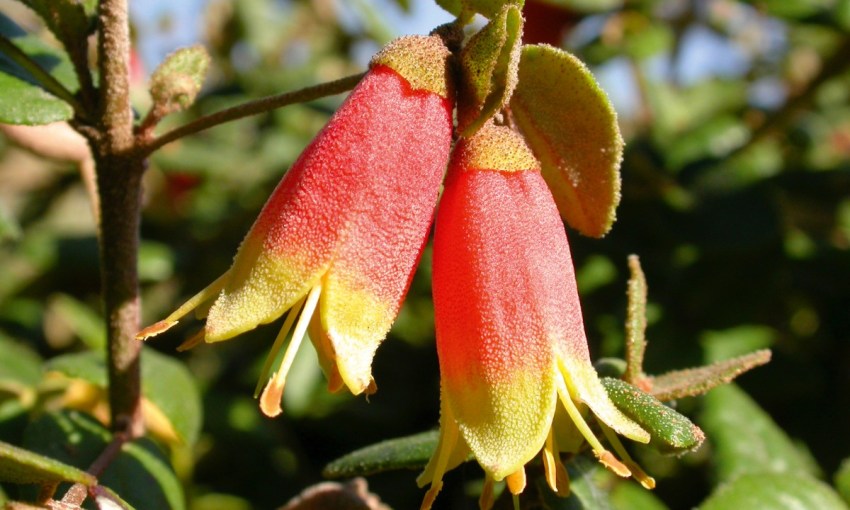Only the hardiest varieties of shrubs and plants can survive the harsh environment of the coastal garden.
Plants worth their salt
To live by the coast is a dream for many of us who have great childhood memories of holidays and weekends spent at the beach. However, for those who actually live beside the seaside, it can be a challenge to establish and maintain a coastal garden. A garden right on the beachfront must be able to withstand regular salt spray, battering winds and sandy soil. A sloping block that directly faces the ocean can be an added disadvantage.
Over the years, a lot of seaside gardens have been comprised of “bits and pieces” of various plants — some might have survived, but many wouldn’t have. Old favourites include geranium, gazania (which so often becomes out of control and overtakes natural flora) and pampas grass. There are the odd struggling trees, grasses that run rampant, massive clumps of cacti and succulents and, of course, the mandatory wormwood.
The success of a seaside garden not only depends on the selection and placement of plants, but also the site of the garden. If a garden is a block or two back from the sea it can make a huge difference to the choice of plants you can consider.
Seaside gardens are categorised into three zones. Zone one is the frontline; the most exposed area on the ocean front, bearing the brunt of strong winds and regular sand-blasting with salt deposits and even seawater droplets.
Zone two is protected by a barrier such as a natural or artificial wind break. Zone three is an area where plants are less likely to be battered by the salt-laden winds. They may be protected by a house or the more mature plantings offered from the other two zones that would provide ample protection for these plants to develop.
For a “zone one” coastal garden, plants must be selected for their ability to survive harsh conditions. This type of area could be described as very hostile and to even think of growing plants (or “pioneers” as they are affectionately called), let alone getting them to survive and flourish, would be a huge challenge; but it can be done.

With Australia’s vast coastline, we are lucky to have a palate of plants that we can use. These tough and hardy varieties have evolved over millions of years to withstand frontline coastal conditions. These plants are the most crucial part of the overall coastal gardening plan. They must grow well to be able to protect the plants that will make up the zone two and three plantings.
There are numerous coastal areas in South Australia that offer protection from the harsh front-line conditions. Some examples can be seen in several delightful gardens on the Yorke and Eyre Peninsulas as well as in some Limestone Coast townships. These are generally facing east, therefore mostly avoiding the prevailing winds.
Like all gardening, it starts with excellent soil preparation followed by ongoing care and general maintenance. It is important to maintain fertility of the soils, which are naturally poor in minerals and trace elements in coastal regions. Today it is straightforward to purchase prescription fertilisers ideal for sandy soils and native plants alike. Manure is an excellent way of introducing water-holding organic particles to starved sandy soils. After planting they must be well watered for the first few weeks to drain any present salts that may be still in the sand.
Some areas are not sandy, such as clifftops, but like all new garden areas it is important to get to know what your soils types are. Regular soil testing to check the pH levels is a good idea so adjustments can be made if necessary.

Aside from water, mulching is the single most important factor that will determine success in your new seaside garden. The list of mulches is a long one, but try to use local products if possible. Grass clippings, animal manures, rocks, gravel or even old washed seaweed can be available in most areas.
Investigate the use of temporary screens and tree guards to assist during the early years of the plant’s life. The use of an automatic drip irrigation system is a must to ensure the plants survive and thrive, particularly when they are young.
In designing your coastal garden, carefully consider the selection of the right species of plant, scale, size, density, texture and colour of those chosen. There are hundreds of plants to choose from at your local coastal specialist nursery or the State Flora Nursery at Belair. Create a coastal garden that will survive, meet your needs and importantly, one you will enjoy.
Plants suitable for coastal regions
Trees and shrubs:
Coast banksia Banksia integrifolia
Drooping sheoak Allocasuarina verticillata
Silver Banksia Banksia marginate
Coastal daisy bush Olearia axillaris
Native fuchsia Correa reflexa
Cushion bush Leucopyhta brownie
Native lilac Hardenbergia violacea
Muntries Kunzea pomifera
Native pelargonium Pelargonium austral
Lavender grevillea Grevillea lanandulacea
Round leaf wattle Acacia acinacea
Hop bush Dodonaea viscosa sp spatulata
Southern Cypress pine Callitris gracilis
Westringia fruticose
Various types of salvia
Rosemary officinalis
Flowering plants:
Native pigface Carpobrotus rossii
Running postman Kennedia prostrata
Common everlasting Helichrysum apiculatum
Native bluebell Wahlenbergia sp.
Diosma Colenema pulchellum
Succulents various
Roses (in Zone 3)
This article was first published in the summer 2018 issue of SA Gardens & Outdoor Living.



